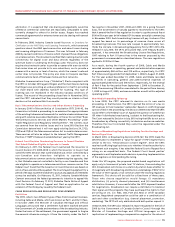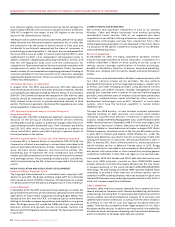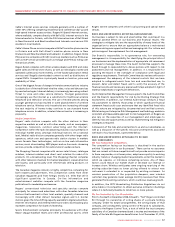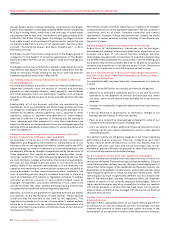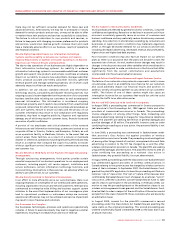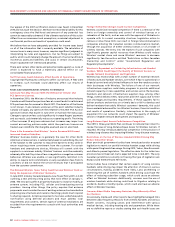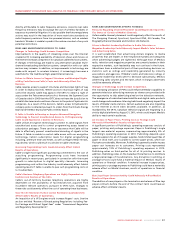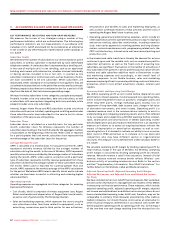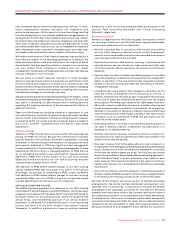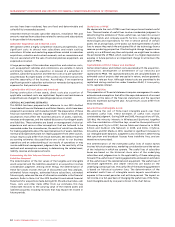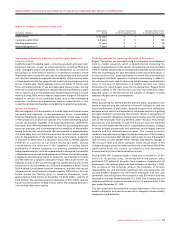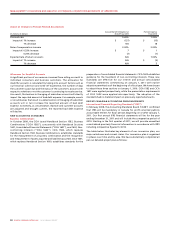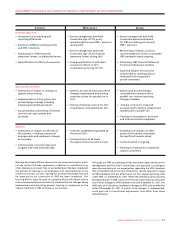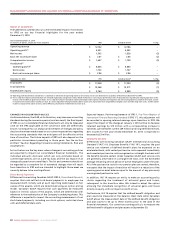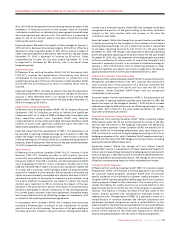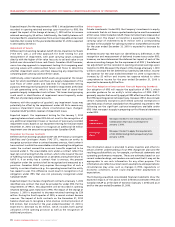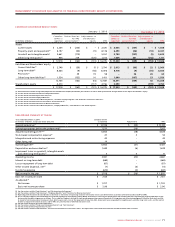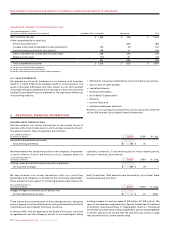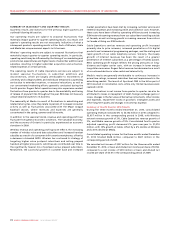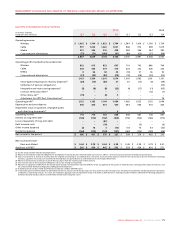Rogers 2010 Annual Report Download - page 61
Download and view the complete annual report
Please find page 61 of the 2010 Rogers annual report below. You can navigate through the pages in the report by either clicking on the pages listed below, or by using the keyword search tool below to find specific information within the annual report.
ROGERS COMMUNICATIONS INC. 2010 ANNUAL REPORT 65
MANAGEMENT’S DISCUSSION AND ANALYSIS OF FINANCIAL CONDITION AND RESULTS OF OPERATIONS
Impact of Changes in Estimated Useful Lives
Impairment of Goodwill, Indefinite-Lived Intangible Assets and
Long-Lived Assets
Indefinite-lived intangible assets, including goodwill and spectrum/
broadcast licences, as well as long-lived assets, including PP&E and
other intangible assets, are assessed for impairment on at least an
annual basis or more often if events or circumstances warrant. These
impairment tests involve the use of both undiscounted and discounted
net cash flow analyses to assess the recoverability of the carrying value
of these assets and the fair value of both indefinite-lived and long-lived
assets, if applicable. These analyses involve estimates of future cash
flows, estimated periods of use and applicable discount rates. During
2010, we recorded an impairment charge of $6 million related to a radio
station licence, due to the weakening of advertising revenues in a local
market. During 2009, we recorded an impairment charge of $18 million
related to certain of our broadcast assets, due to the challenging
economic conditions and weakening industry expectations in the
conventional television business and a decline in advertising revenues.
Income Tax Estimates
We use judgment in the estimation of income taxes and future income
tax assets and liabilities. In the preparation of our Consolidated
Financial Statements, we are required to estimate income taxes in each
of the jurisdictions in which we operate. This involves estimating actual
current tax expense, together with assessing temporary differences
that result from differing treatments in items for accounting purposes
versus tax purposes, and in estimating the recoverability of the benefits
arising from tax loss carryforwards. We are required to assess whether
it is more likely than not that future income tax assets will be realized
prior to the expiration of the related tax loss carryforwards. Judgment
is required to determine if a valuation allowance is needed against
either all or a portion of our future income tax assets. Various
considerations are reflected in this judgment, including future
profitability of related companies, tax planning strategies that are
being implemented or could be implemented to recognize the benefits
of these tax assets, as well as the expiration of the tax loss carryforwards.
Judgments and estimates made to assess the tax treatment of items
and the need for a valuation allowance impact the future income tax
balances as well as net income through the current and future income
tax provisions. As at December 31, 2010, and as detailed in Note 7 to the
2010 Audited Consolidated Financial Statements, we have non-capital
income tax loss carryforwards of approximately $188 million. Our net
future income tax liability, prior to valuation allowances, totals
approximately $470 million at December 31, 2010 (2009 – liability of
$125 million). The recorded valuation allowance of $47 million reduces
future income tax assets to $323 million, which the Company believes it
is more likely than not to realize.
(In millions of dollars)
Amortization
Period
Increase in Net Income
if Life Increased by 1 year
Decrease in Net Income
if Life Decreased by 1 year
Brand names 5–20 years $ 1 $ (1)
Customer relationships 2–5 years $ 5 $ (10)
Roaming agreements 12 years $ 3 $ (4)
Marketing agreement 5 years $ 2 $ (3)
Credit Spreads and the Impact on Fair Value of Derivatives
Rogers’ Derivatives are recorded using an estimated credit-adjusted
mark-to-market valuation, which is determined by increasing the
treasury-related discount rates used to calculate the risk-free estimated
mark-to-market valuation by an estimated Bond Spread for the relevant
term and counterparty for each Derivative. In the case of Derivatives in
an asset position (i.e., those Derivatives for which the counterparties
owe Rogers), the Bond Spread for the bank counterparty is added to
the risk-free discount rate to determine the estimated credit-adjusted
value. In the case of Derivatives in a liability position (i.e., those
Derivatives for which Rogers owes the counterparties), Rogers’ Bond
Spread is added to the risk-free discount rate. The estimated credit-
adjusted values of the Derivatives are subject to changes in credit
spreads of Rogers and its counterparties.
Pension Plans
When accounting for defined benefit pension plans, assumptions are
made in determining the valuation of benefit obligations and the
future performance of plan assets. Delayed recognition of differences
between actual results and expected or estimated results is a guiding
principle of pension accounting. This principle results in recognition of
changes in benefit obligations and plan performance over the working
lives of the employees receiving benefits under the plan. The primary
assumptions and estimates include the discount rate, the expected
return on plan assets and the rate of compensation increase. Changes
to these primary assumptions and estimates would impact pension
expense and the deferred pension asset. The current economic
conditions may also have an impact on the pension plan of the Company
as there is no assurance that the plan will be able to earn the assumed
rate of return. As well, market-driven changes may result in changes in
the discount rates and other variables which would result in the
Company being required to make contributions in the future that differ
significantly from the current contributions and assumptions
incorporated into the actuarial valuation process.
During 2009, the Company made a lump-sum contribution of $61
million to its pension plans, following which the pension plans
purchased $172 million of annuities from insurance companies for all
employees in the pension plans who had retired as of January 1, 2009.
The purchase of the annuities relieves the Company of primary
responsibility for, and eliminates significant risk associated with, the
accrued benefit obligation for the retired employees. The non-cash
settlement loss arising from this transaction was $30 million and was
recorded in the year ended December 31, 2009. The Company did not
make any additional lump sum contributions to its pension plans in the
year ended December 31, 2010.
The following table illustrates the increase (decrease) in the accrued
benefit obligation and pension expense for changes in these primary
assumptions and estimates:


